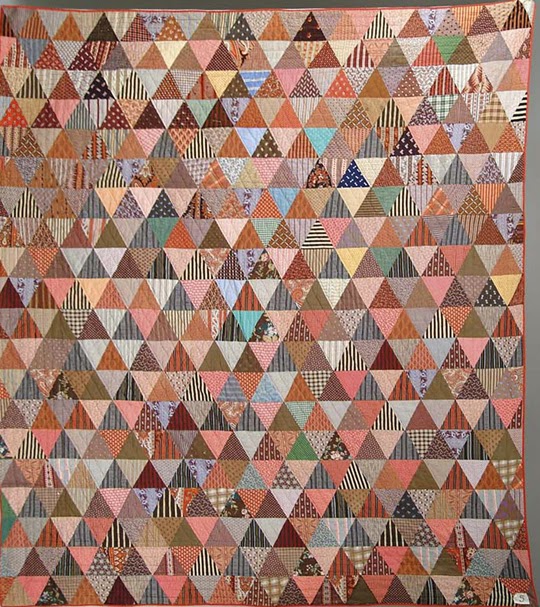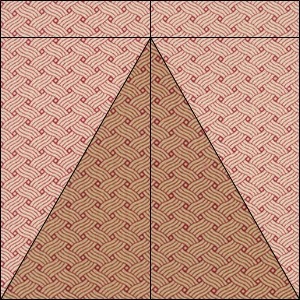Thousand Pyramids Charm quilt and Dorothy Barker
I recently got out an old reproduction quilt and spread it over Dot's love seat.
I made the triangle quilt in the early 1990s and it's been folded up
too long. I thought I'd lay it out for a week or two to get out the wrinkles
and then refold it.
The base of the finished triangles on this one measures 2". They are isoceles triangles,
with the base shorter than the side lengths.
I had made my mother-in-law a bed-size, charm quilt like this and
I made a smaller one for me with the leftovers
This was before I was working with Moda to design reproductions so the darks and lights were from my scrapbag, prints not really marketed at the time as reproductions. I overdyed the really bright white shirting prints with tan Rit Dye to tone them down. I was looking for madder reds and browns, pinks and shirting prints.
Sort of like this one from about 1870-1890
I remember that I was frustrated in piecing this because the differences in the measurements on the sides were hard to see and I was always attaching a base to a side and having to rip.
I have been looking for a paper piecing project that is NOT hexagons. I think I'll make another one of these with my own Moda reproductions. But I will use equilateral triangles, in which all the angles are 60 degrees and all the sides are the same length.
I looked that pattern up in my BlockBase program and
saw that it is #111a with several names.
I like Joseph's Coat from the Joseph Doyle Company about 1910 and Thousand Pyramids from Ruth Finley's 1929 quilt book.
You can buy paper piecing patterns for equilateral triangles already cut. If you want to cut your own: Paper Pieces gives you a free equilateral triangle grid to print out. Click on this link and scroll down.
I fooled around with their grid: Enlarged it 110% and fit it onto an 8x11 sheet which I printed on index paper.
Click on this image and Save it to a JPG file or a Word file.
Print it out on an 8-1/2 x 11" sheet of heavy paper.
The triangles measure 2" on each of the 3 sides.
If you want to stitch triangles without paper templates here's how to cut
an equilateral triangle from a charm pack.
I have a Charm Pack (5" squares) of my Richmond Reds reproduction line from Moda.
Cutting equilateral triangles from
Moda Charm Pack Squares:
Begin with a 5" square.
Press the square in half so you
have a fold line down the middle.
Cut a strip off the top 5/8" wide.
Cut a line from the center top of the fabric
to the exact corner on either side.
Your triangle will be 5" on all three sides.
You are ready to make a charm quilt with no two pieces alike.
The larger triangles really show off the prints.
Charm quilt from the 1870-1900 period
Quilt about 1880-1920 from the Nickols Collection
at the Mingei Museum.
You might be better off aiming for a charming quilt with duplicate prints. It's the
scrappy look that is so appealing.
The quilt above looks like it was begun on the top left side
with madder browns popular in the 1870-1890 period and finished in
the lower right with blues and grays popular in the 1890-1920 period.
Don't dawdle too long. Taste could change.
Charming quilt from 1930-1960 with the triangles shaded in diagonal rows.
Here's an updated look from Carla at Grace & Favour blog who used a
Cherry Christmas charm pack
by Aneela Hoey from a few years ago. (Carla's look to be isosceles triangles---(longer sides, shorter base) They still work.
Thousand Pyramids from about 1880-1920
I'm making progress in just a few days. And I found I still have some scraps
left over from the first project over 20 years ago.
You have to be nuts to save scraps that small.
So I was browsing the web after writing the above and I see somebody
at Atelier Bep had the same idea using my Richmond Reds. And she's finished already.


































































